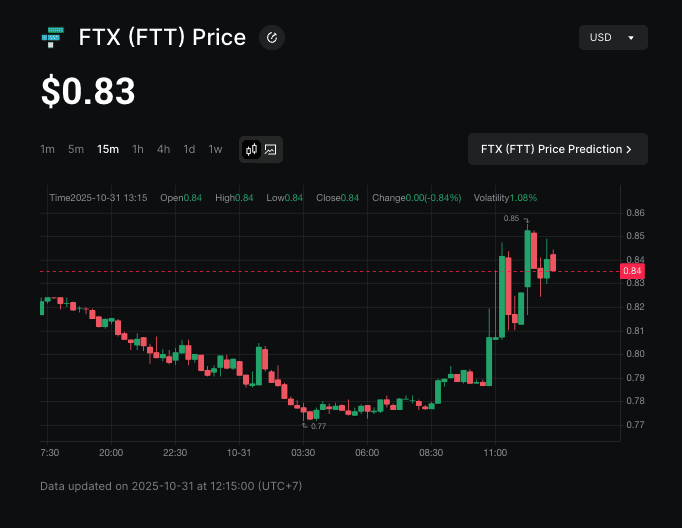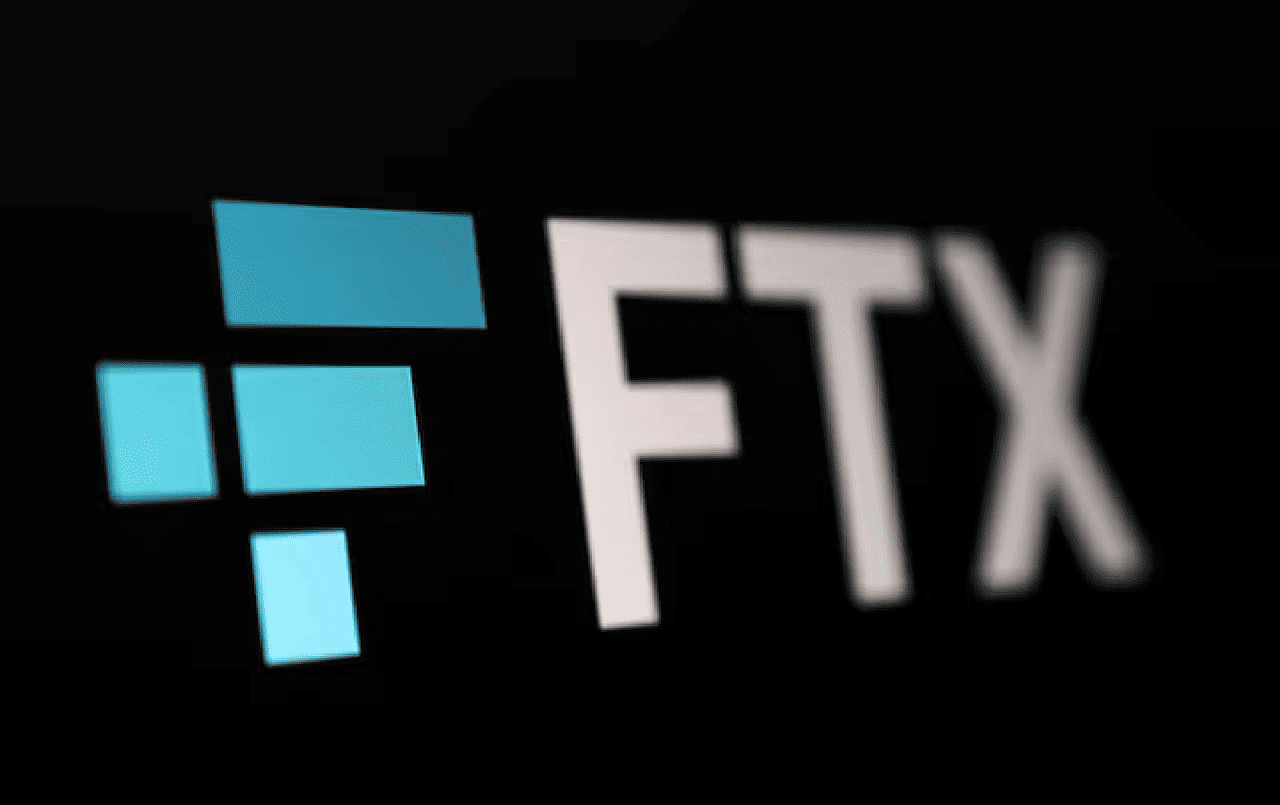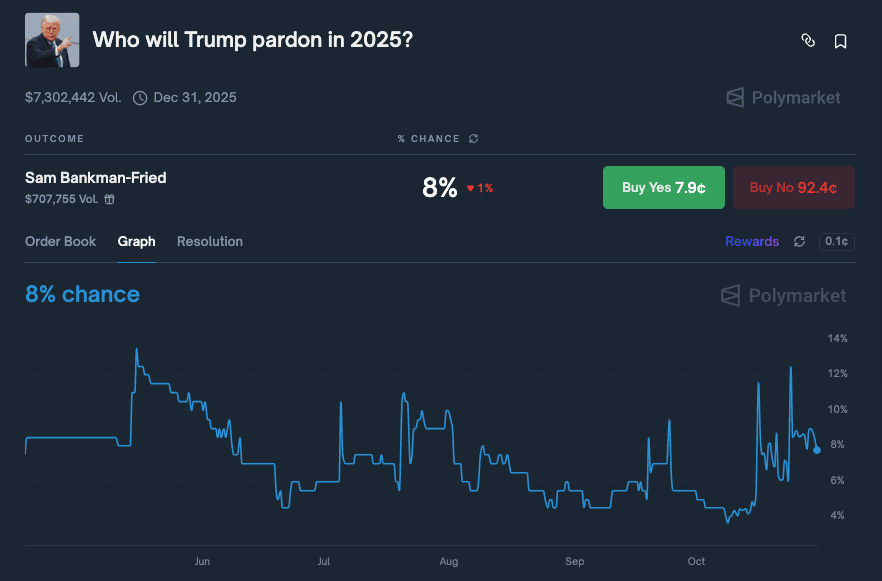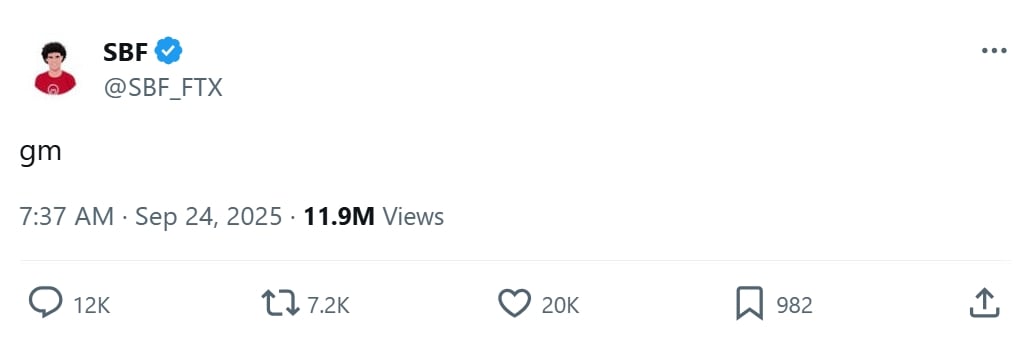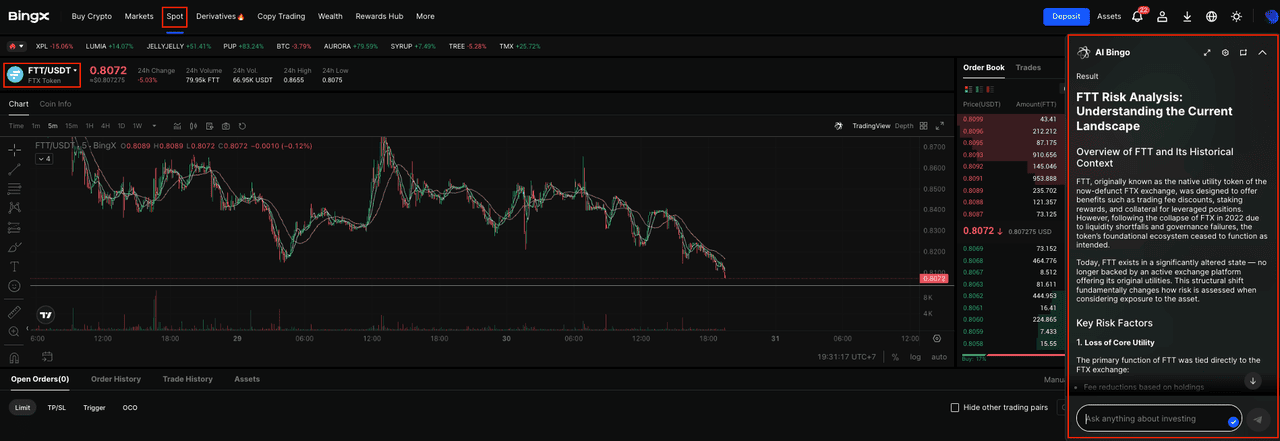FTX's native token,
FTT, continues to attract speculation. On October 24, 2025, the token surged by 16.9%, in line with a wider crypto rally fuelled by speculation surrounding a potential pardon for the former FTX CEO, Sam Bankman-Fried (SBF). Earlier, U.S. President Donald
Trump’s pardon of Binance founder CZ had clearly lifted market sentiment. These political jolts are often short-term bullish, but they are fragile. When rumors fade, prices can reverse abruptly.
SBF keeps the narrative alive. On October 16, 2025, he claimed his 2022 arrest was politically motivated to prevent testimony on crypto regulation. That does not change the fundamentals, but it keeps FTT in headlines and fuels short bursts of interest.
This article explains what FTT is, traces its rise and collapse, and sets out the major risks you should weigh before trading.
FTT Token 4h Chart | Source:
BingXWhat Is FTX (FTT) and How Does It Work?
FTT was the native token of the now-defunct crypto exchange FTX. It served as a utility token for fee discounts,
staking perks, derivatives collateral, and a deflationary buy-and-burn mechanism. The tokenomics allocated part of FTX's revenues to repurchase FTT and then destroy it. More than 20 million tokens were removed from circulation before the bankruptcy. The maximum supply is 328.9 million.
Since FTX collapsed in November 2022, its real-world utility has vanished. As of 2025, there is no substantive code development, and the tokenomics are effectively frozen. The former benefits, such as fee tiers, staking rewards, and access features, no longer exist without a platform. Market frameworks also shifted. On May 9, 2025, Binance cut FTT’s portfolio margin collateral ratio from 20% to 10%, which reduced its role in leveraged strategies and tilted sentiment bearish.
In short, FTT now trades as a speculative
altcoin without a functioning ecosystem. If you trade FTT pairs, you are trading narratives rather than fundamentals. Keep positions small, check liquidity, and budget for slippage when managing your
crypto wallets.
The FTX Story
FTX rose rapidly, using innovative derivatives and a centralized collateral pool to become a market leader, reaching a $32 billion valuation in 2021. FTT printed its all-time high at $85.02 on September 9, 2021. High-profile sponsorships and deals, including MLB branding and the LedgerX acquisition, drove visibility. In November 2022 the crash came: a liquidity crisis, bankruptcy, and investigations.
There were isolated reactions in 2023. Talk of a possible reboot briefly lifted FTT in April. In September, Binance listing the FTT/USDT pair added about 8%. None of this fixed the core problem. SBF was convicted on seven counts in November 2023 and sentenced to 25 years, with an expected release date of October 25, 2044. An “FTX 2.0” did not materialize, and development on FTT stalled. Still, speculation flares whenever legal milestones or social media sparks appear.
Oct 31, 2025: SBF’s X account posted a 14-page memo claiming a short-term liquidity crunch, not insolvency. It says FTX in 2022 had $25B in assets plus $16B in equity against $13B in liabilities. If FTX and Alameda had kept their portfolio, it would now be about $136B including a hypothetical $14.3B stake in Anthropic and $7.6B in Robinhood, putting FTT near $22B marketcap.
For many, FTT is a zombie asset: it can be traded, but it lacks a sustainable future. Its price pattern shows sharp, short spikes followed by swift rollovers, making it more akin to
memecoins and news trades than to mature crypto sectors.
Can Politics Push FTT? CZ Pardon and SBF Odds
Politics can move FTT
Trump’s Oct 23, 2025 pardon of CZ drew sharp criticism in Washington and applause in parts of crypto, and the takeaway for speculative traders is that clemency is possible, which keeps FTT highly sensitive to headlines; prediction markets briefly raised odds of an SBF pardon, and FTT saw quick rumor-led spikes despite limited utility post-bankruptcy.
Pardon chatter fuels narrative momentum
Following CZ's pardon, attention turned to whether SBF could be next. On Polymarket, the odds of his release before the end of the year reportedly jumped from 4% to 12% within hours. This is not proof, but it supports the narrative that traders are reacting to.
Poll: Will Trump pardon SBF in 2025? | Source:
PolymarketSBF’s legal profile is tougher than CZ’s
He faced sweeping financial misconduct claims with broad damage. Unlike CZ, he went to trial, was convicted on all counts, and is widely viewed as unrepentant, which makes any pardon politically explosive. The possibility of clemency collides with resistance from regulators and lawmakers. That tension sets up sharp rallies followed by abrupt reversals, creating whipsaw risk for anyone chasing moves.
Social media remains an accelerant
A simple “gm” posted from SBF’s account in September 2025 sent FTT up about 46% within minutes. Most of those gains faded soon after, underscoring how quickly sentiment can flip.
How to Trade FTX (FTT) on BingX
Whether you are building a long-term FTT position, trading short-term volatility. BingX provides flexible ways to trade the token. With
BingX AI integrated directly into the trading interface, you can access real-time insights to support smarter trading decisions across both spot and futures markets.
FTT/USDT trading pair on the spot market powered by Bingx AI
2. Plan the trade: On the chart, click the AI icon to view support and resistance, breakout zones, and suggested entry areas. Decide your entry, stop loss, and take profit.
3. Place and manage the order: Choose Limit or
Market, set size, and confirm. Add your stop loss and take profit immediately. If needed, deposit FTT or USDT and verify the correct network before trading.
Note: This is not financial advice. Crypto assets, especially FTT, carry a very high level of risk. Only ever trade with money that you can afford to lose.
FTT Trading Risk Brief
• No active ecosystem: FTX is wound down; FTT has no functional use case today.
• Frozen code and tokenomics: No meaningful updates since 2022; burn mechanics effectively stopped.
• Exchange policy risk: Collateral rules can tighten without notice. Always confirm your exchange’s margin treatment before
trading.
• News and politics beta: Pardon chatter, court dates, and social posts can trigger 20–60% intraday swings.
• Liquidity traps: Spikes bring slippage and wide spreads, especially with market orders.
• Legal overhang: Ongoing legal processes and potential policy shifts can reshape the setup.
• Creditor flows: Repayment timelines can sway sentiment and perceived sell pressure.
• Narrative-driven price: Price discovery relies on story cycles, not fundamentals. Adjust size, leverage, and holding periods accordingly.
Conclusion
FTT trades less like a utility asset and more like a headline derivative on the FTX–SBF–U.S. politics saga. Short, sharp rallies can appear on clemency headlines, court moves, or viral posts. They can vanish just as quickly because fundamentals are absent.
If you trade FTT, treat it as a high-volatility event trade. Define setups, set invalidation levels, take partial profits, and respect liquidity limits. Track milestones such as creditor distributions and expect political headlines to set the rhythm. For long-term allocation, FTT offers little today. For disciplined short-term trading, it can present opportunities as long as you manage risk and remember: narrative rallies are lighter fluid.
Related Reading

